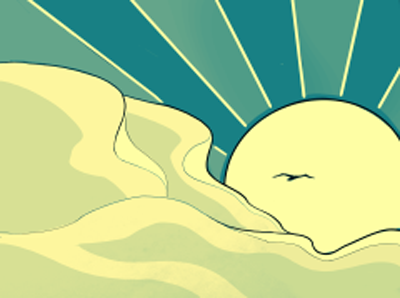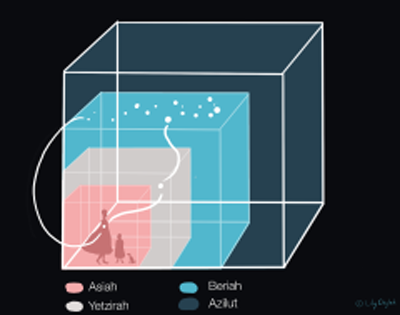The Creation Story: Second Day
by Petr Chylek (February 2023)

The Creation of Light, George Richmond, 1826
To start, let us review what happened on Day One of the creation story. According to Zohar, the fundamental book of Kabbalah, on day one He created Elohim, the heaven and the earth. Elohim said “Let there be light,” and there was light; and Elohim saw that light was good (Genesis 1:3).

The second day of creation is different. According to the Old Testament or Torah, on the second day of creation Elohim said:
Let there be a firmament in the midst of the waters, and let it divide the waters from the waters. And Elohim made the firmament, and separated the waters which were under the firmament from the waters which were above the firmament; and it was so. And Elohim called the firmament heaven. And there was evening and there was morning a second day. (Genesis 1:6-8)
Most medieval commentators treat this day very superficially, almost ignoring the second day, trying to impress upon us that nothing of interest happened here. It is only Nachmanides (1194-1270) who leads us in the right direction. In his Commentary on the Torah [2] he writes concerning the second day:
This is a part of the process of creation which those who know it are obliged to conceal … as the subject is one of the mysteries of the Torah, and to give the interpretation is forbidden even to those who know it.
This sounds like someone trying to stimulate our interest. Thus, let us look at a few differences between the first and the second day. On day one, Elohim said: “Let there be light,” and there was light (Genesis 1:3). Thus, on day one Elohim was able to create just by saying; to create just by the sound. On the second day this way of creation did not work. After Elohim said let there be Rakiah, nothing happened, and Elohim had to make Rakiah. You see the difference? And to confuse the situation even more, the Elohim of the second day tells us that Rakiah is a heaven, while we were told that heaven was created on day one. Was Elohim trying to convince us that this Rakiah is a real heaven?
Before we proceed further, let us clarify what is called by King James version and many others a firmament. The Hebrew word is Rakiah, and nobody really knows what Rakiah is. Some translators call it the firmament, others call it sky, still others call it space or a heaven; and some do not translate it at all and they leave it as Rakiah. Thus, it seems that we simply do not know what Rakiah means.
On day one, Elohim created the Light, which connected the Heaven and the Earth. It provided a channel for direct communication and flow of energy between the Heaven and the Earth; nothing stood between them. On the second day, Elohim made a Rakiah that separated water above form water below. Thus, on day one the connection was established, while on the second day the separation was made and Rakiah was inserted between the heaven and the earth. On day one, after the creation the Elohim said it was good, while the second day is the only day of the process of creation on which Elohim did not say that it was good, which means perhaps that it was not good. Some early commentators (e. g. Rashi) suggest a non-convincing explanation that on the day one heaven was not yet solidified, it was still wet, and that it solidified only on the third day.
In addition, there is a spiritual meaning of the light. Many stories of Bible are allegorical and things are not what they appear to be. Spiritual meanings are allegorically represented by the things we know from our daily experience. The light is used to represent knowledge, wisdom, energy or guidance in an allegorical sense. It is something that can enlighten people. The light cannot be stopped. You cannot lock the light in a suitcase and store it, or carry it to another place; it would disappear. It has to keep moving. If you gain knowledge and wisdom and want to keep it for yourself to show that you know more than your neighbors, your light, your knowledge and wisdom would disappear. The light has to keep moving. The wisdom that is acquired for yourself will not survive. The wisdom that is acquired to share with others, to teach, will survive.
Water can also represent the truth. It can be pure or in all states in between pure and muddy. It can flow, or it can be held steady. We can never know the perfect absolute truth; only an approximation. Our water is always only partially pure. All laws of our science are only approximations. With time they can change and become more accurate, but always only approximations. The same with the truths we know. Never insist that you know perfectly how things are or how they were. There is always a chance that you may be wrong. Remember that. “What gets us in trouble is not what we don’t know. It is what we know for sure that just is not so” (Attributed to Mark Twain).
We have seen (Creation Story: Day One) that according to Zohar, He, the Infinite One, created Elohim, the Heaven and the Earth. The word Elohim is a masculine plural form in Hebrew. Thus, there are apparently several “Elohims,” several spiritual entities participating in the creation of the universe. Is it possible that one of them, Elohim working on second day, is disobedient? One that does things of his own invention, not according to the will of the Creator? This thought is not far-fetched. In Christian Gnosticism, which flourished during the first few centuries of the common era (CE), there is a false god who created our physical universe and who opposes the true Good God. Some academic scholars put the date of canonization of the Genesis part of the Old Testament to the middle of the second century CE. Thus, it is possible that the final touches of the Book of Genesis were influenced by Gnostic philosophy; several Elohims was not so strange as it seems to be today.

According to Kabbalah there is a physical world and there are several spiritual worlds (Fig. 1). The physical world, the world of action (the world of ASIAH in Hebrew) can be detected by our physical senses, while spiritual worlds cannot. The lowest spiritual world, next to our physical world, is called the world of formation (the world of YETZIRAH in Hebrew). This world is sometime called The World to Come in medieval Jewish writings. The next spiritual world is the world of creation (the world of BERIAH in Hebrew). The Biblical Genesis starts with the creation of the Heaven (BERIAH) and the Earth (ASIAH) next to each other, so that the light can easily proceed from Heaven to Earth. The Heaven and Earth are really joined together forming one unit. Now, on the second day, the RAKIAH is formed that separates water above (in BERIAH) from water below (in ASIAH), meaning that the truth, wisdom and knowledge of Heaven is now separated from the truth, wisdom and knowledge as seen by the Earth. It is the world of YETZIRAH, called also the astral plane in other traditions, which now separates the heaven from the earth, and this can block or at least interfere with the light that could originally easily pass from heaven to the earth. And the Elohim of the second day is telling us that this world of YETZIRAH is the heaven. Is this an aberration in the process of creation? Or is this a plan intended from the beginning? In any case, the creation is now imperfect, and we don’t need a fall of Adam to make the world of need of repair.
Four Kabbalistic worlds of Asiah (our physical World of Action), world of Yetzirah (the first spiritual world called the World of Formation, an astral world I other traditions), world of Beriah (World of Creation), and the Azilut (World of Emanation). White circles and the paths represent the Soul and its journey.
The 13th century Rabbi Joseph Gikatilla (1248-1305) describes the world of YETZIRAH (astral world) in his book Gates of Light (SHAAREY ORAH) saying [3]:
A man must be aware that there are no open places from the Earth to the Heavens. Every place is filled with legions and hordes. Some are full of mercy others are impure creatures to seek to detract and to harm. Some are for peace and some for war, some warrant good and others evil, some are for life and others for death. All these entities are gangs who dwell between heaven and earth.
Thus, a direct communication between the heaven and the earth is disrupted and consequently, man lives in a partial (or a complete) darkness.
From the Jewish writers it is only Isaac Luria (1534-1572), as far as I know, who recognized that the BERIAH (Heaven) and ASIAH (Earth) were created first, and the YETZIRAH, the world of Formation also known as Astral world, was made between them later [4]. This is according to the Old Testament what happened on Day One and Second Day. Here I leave the names of the first two days exactly as stated in Torah.
A similar theme is presented in Chinese Book of Change, I Ching [5], composed according to some scholars during the third millennium BC. The first construct in I Ching is the Heaven. The second is the Earth. This is followed by what is usually called a Difficulty. Confucius (551-479 BC) in his comments on I Ching writes:
After Heaven and Earth came into the existence, myriad things were produced. These things fill up the space between the Heaven and the Earth.
I cannot miss the similarity between the saying of Confucius and the above cited words of Joseph Gikatilla. The creation presented in the I Ching is parallel to the first two days of Biblical creation. After creation of the Heaven and the Earth comes the problem: the Difficulty of I Ching, and RAKIAH separating the Heaven and the Earth of Genesis. Joseph Gikatilla explains why these things, mentioned by Confucius, filling the space between the Heaven and the Earth, create difficulty. Thus, the world of YETZIRAH prevents a direct communication from heaven to earth. It however, also protects heaven from consequences of man’s evil thoughts and deeds. We may say that it serves good with some not so good consequences.
Do we still need Adam and Eve to eat the forbidden fruit to make the world imperfect? Don’t we already have enough difficulties? Thus, what to do? How to fix it? How to reconnect the Heaven and the Earth? For this we have to wait till the Sixth Day of Creation.
References
[1] The Creation Story: Day One. New English Review, November 2022.
[2] Ramban Nachmanides, Commentary on the Torah. Shilo Publishing House, 1999.
[3] Joseph Gikatilla, Gates of Light. HarperCollins, 1994.
[4] M. Wisnefsky, Apples from the Orchard, Gleaning from the Mystical Teaching of Rabbi Yitzchak Luria. Thirty-Seven Books, 2006.
[5] Wilhelm Baynes, I Ching. Princeton University Press, 1977.
Table of Contents
Petr Chylek is a theoretical physicist. He was a professor of physics and atmospheric science at several US and Canadian universities. He is an author of over 150 publications in scientific journals. He thanks Lily A. Chylek for illustrations used, for reading the earlier version of this article and for her comments and suggestions.